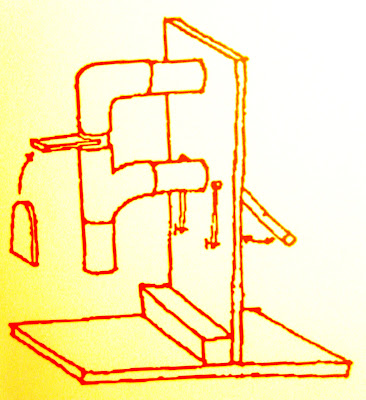'THE RESIDENCE OF
ERASMUS DARWIN M.D. F.R.S.
BORN 1731. (FROM 1756 TO 1781.) DIED 1802.
AUTHOR OF "THE BOTANIC GARDEN" & C.'
ERASMUS DARWIN M.D. F.R.S.
BORN 1731. (FROM 1756 TO 1781.) DIED 1802.
AUTHOR OF "THE BOTANIC GARDEN" & C.'
Darwin was the grandfather of Charles Darwin and a physician, scientist, inventor, poet and botanist. The above date of Darwin's arrival at the house in Lichfield, Staffordshire, is slightly incorrect: he in fact moved here in 1758, less than a year after marrying Polly Howard, by whom he had three sons. Polly died in 1770.
A model of Darwin looks out onto Beacon Street.
After the death of his wife, Darwin had two daughters by Mary Parker, a young woman employed to help with the children.
The third edition of The Botanic Garden, dated 1791.
Interpretation panels mention the influence of Darwin's writings on other writers. One states that he influenced 'nearly all' the early Romantic poets, and draws attention to Darwin's The Loves of the Plants influencing Blake's The Book of Thel. Also mentioned is Darwin's influence on the young (although not the older) Wordsworth and Coleridge in, for example, The Rime of the Ancient Mariner (1798), and also the later published 'Kubla Khan' (1816). Also briefly mentioned are Keats and Shelley, with a note giving what is almost certainly the writer's only source of reference: Desmond King-Hele's Erasmus Darwin and the Romantic Poets (Basingstoke: Macmillan, 1986).
The Temple of Nature; or, the Origin of Society: A Poem, with Philosophical Notes (London: J. Johnson, 1803): a posthumous publication. There have been many editions of this book, some of them published relatively recently.
An example of Darwin the inventor: a sketch of his effective speaking machine, built in 1771.
A reconstruction of Darwin's study, with Joseph Wright's portrait of him above the mantelpiece and, by the model's head:
Darwin's friend Anna Seward, painted by T. Kettle in 1762. I briefly mentioned her earlier when I showed photos of her memorial in Lichfield Cathedral. The link is at the bottom of this post.
Also in Erasmus Darwin House is the portrait of the Reverend Chancellor Thomas James Law, described by an unnamed source as a 'one man civic society'. Law gave the town the statue of Samuel Johnson in the Market Square in Lichfield (also shown, in several images, in a link below), the country's second free library (in Beacon Street), and the fountain in the museum gardens.
Law was buried in St Michael's churchyard in Lichfield. There is a local tale that the tomb (built for his wife) is elaborate because it is in defiance of the council, which wouldn't allow him to erect a Gothic canopy over Johnson's statue like the statue of Sir Walter Scott in Edinburgh.
'The home of
Erasmus
Darwin
from 1758
until 1781'
In 1775 Darwin met Elizabeth Pole, a married woman from Radbourne Hall in Derbyshire whom he married in 1781, the year after her husband's death. Erasmus moved with his wife to Radbourne Hall, and then to Full Street, Derby, in 1783; in 1802 he died, just a few weeks after moving to Breadsall Priory and just four months before the death of his much younger wife (by whom he had seven more children).
A back view of the house.
Only a few yards from Darwin's house, and still on Beacon Street:
'ON THIS SITE STOOD
THE HOME OF DAVID GARRICK,
BORN 1716. [Actually 1717.] DIED 1779.
PULLED DOWN IN 1856.
––––––––––––
EDUCATED AT LICHFIELD GRAMMAR SCHOOL.
BURIED AT WESTMINSTER ABBEY.'
Noel Jackson: 'Rhyme and Reason: Erasmus Darwin's Romanticism'
Anna Seward (1747-1809), Lichfield, Staffordshire
Dr Samuel Johnson and Lichfield, Staffordshire















No comments:
Post a Comment